
Peach Diseases
Peach Diseases
1. Peach leaf curl
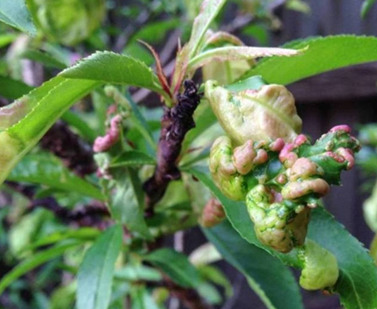
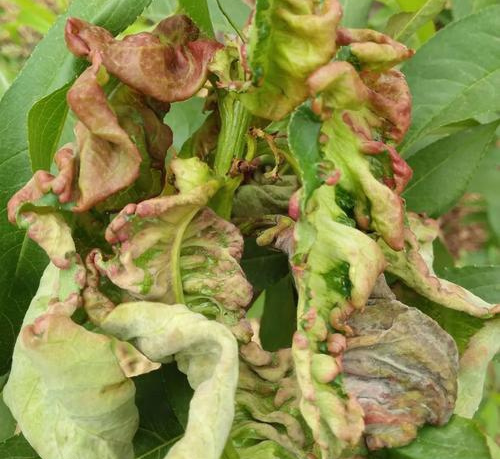
Hazard symptoms: (1) Branches: The infected tender twigs are gray-green or yellow, the internodes are shortened and slightly swollen, and in severe cases, the infected branches gradually die down. (2) Leaves: In spring, the young leaves are curled and reddish in color as soon as they just sprout, and the degree of shrinkage intensifies after leaves unfold. The leaf surface is uneven; the diseased part is swollen. The mesophyll is hypertrophic and brittle, gray-green in the early stage, and later becomes red or purple-red. When wet, there is white powder in the diseased part, and finally the diseased leaves become brown or dark brown, dry and fall off. The young leaves suffered from severe disease turn black, dry and die before they unfold. (3) Fruits: The young fruits appear yellow or red spots at the early stage of disease with slight bulge and gradually become brown as the fruit grows. The fruits crack and are easy to fall early. The diseased part of the large fruit is swollen, the hairs fall off, and the surface is smooth. The diseased fruits will rot when the weather is wet.
Characteristics of disease occurrence: The pathogen is Taphrina deformans (Berk.) Tul., belonging to ascomycotina fungus. The optimum growth temperature of pathogen is 20°C, the lowest is 10°C, and the highest is 26-30°C. The optimum temperature of infestation is 10 ~ 16°C. Ascospores or spores overwinter on the scales of peach buds or sneak into the slits of the scales, and invade the tender buds during the germination of peach buds in early spring. The disease usually occurs from April to May and occurs only once a year. Early-maturing varieties are susceptible to disease, and seedling peach trees are more susceptible to disease than grafted peach trees. Low temperature and high humidity are prone to disease, and the disease is serious along river banks, lakesides and low-lying wet land.
Prevention and control measures:
(1) Plant disease-tolerant varieties. From April to May, when the diseased leaves are first seen but there is no silver-gray powder, remove immediately and take out of the field for treatment. Peach orchards with serious disease should be topdressed and irrigated in time to enhance tree growth and improve disease resistance.
(2) Before the peach buds become red but not yet unfolded, apply lime Sulphur (1-1.5 Baume degrees), or Bordeaux mixture (1:1:100), or Mancozeb 70% WP, or Thiophanate-methyl 70% WP. When diseased leaves first appear on the plant, apply Chlorothalonil 75% WP or Carbendazim 25% WP.
2. Peach powdery mildew
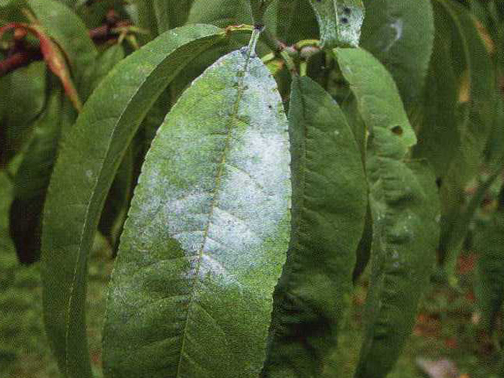
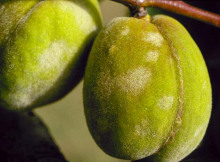
Hazard symptoms: (1) Branches: White hyphae appear on diseased new shoots before they age. (2) Leaves: Nearly round or amorphous white mildew spots appear at the initial stage of disease, and then the mildew spots gradually expand and develop into white powdery spots. White powder spots can join together to form plaques, and in severe cases, most or even all of the leaves are covered with white powder. The diseased leaves will be chlorotic, dry and fall off. (3) Fruits: White round or irregular powdery hyphae plexus appear on diseased fruits, the tissue near the epidermis dies, forming light brown spots, which are then slightly sunken and hardened.
Characteristics of disease occurrence: There are two pathogens, the one is Podosphaera tridactyla Wallr de Bary and the other is Sphaerotheca pannosa (Wallr.) Leveille var. Persicae Worornichi.. They both belong to ascomycotina fungi. The germination temperature of conidium is 4-35°C, and the optimum temperature is 21-27°C. After 3 to 4 hours in direct sunlight, or 24 hours in scattered light, the germination potential will be lost, but the frost resistance is strong, and conidium can still germinate in case of late frost. The pathogens overwinter on the surface of innermost bud scale, and conidia are produced in spring as inoculum for initial infection and re-infection, which are spread by air flow to complete the annual cycle of the disease, and the overwintering period is not obvious.
Prevention and control measures:
(1) After autumn, clean up the orchard, sweep away fallen leaves and burn.
(2) Apply Triadimefon 20% EC, Diniconazole 12.5% WP or Propiconazol 25% EC.
3.Peach bacterial shot hole
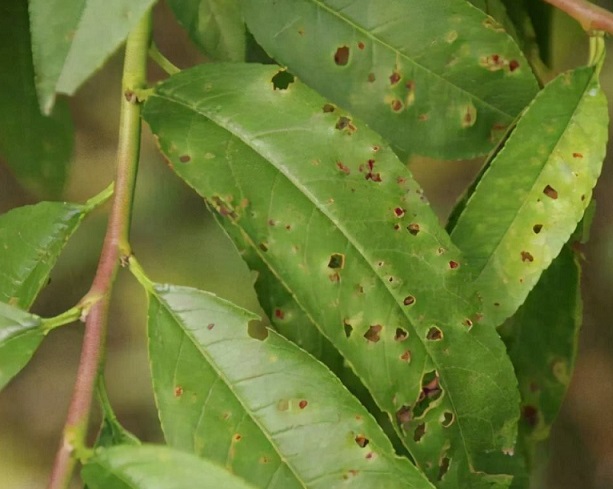
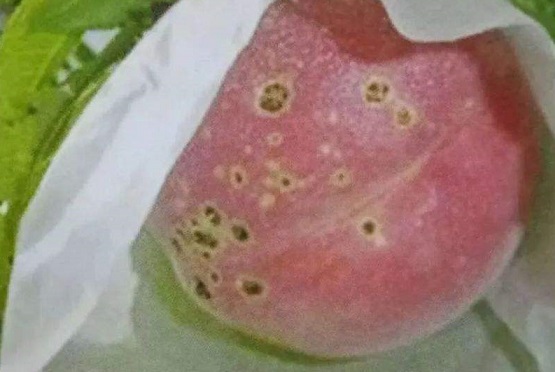
Hazard symptoms: (1) Branches: There are two kinds of disease spots. Spring canker spots: Occurs on branches that have been infected in the summer of the previous year. When new leaves appear in spring, small water-stained dark brown herpes are formed on the branch tips, about 2mm in diameter, and later expand to 1-10cm, but the width does not exceed 1/2 of the diameter of the branches. At the end of spring, the epidermis of the disease spot rupture, and the pathogen spill out and begin to spread. Summer canker spots: Occurs in late summer mostly. Water-stained purple-brown spots are formed on young shoots of the current year, round, with a depression in the center. Finally, after cortical longitudinal crack, the disease spots are not easy to expand, and the branches will die when there are many spots. (2) Leaves: In the early stage, small water-stained light brown spots appear on the back of the leaf near the veins, and then also appear on the leaf surface, mostly are scattered at the tip or edge of the leaf. After the spots expanding, they become purple-brown to dark-brown round or irregular spots with keratinized edges and water-stained yellow-green halo around them, and finally the spots dry up. A ring of cracks occurs at the junction of the diseased and healthy parts, and the central tissue of the disease spots fall off to form a shot hole. (3) Fruits: Initially, it is a small water-stained brown spot, and then it expands and becomes dark purple with a slightly sunken center and water-stained edges. When the weather is humid, yellowish-white viscous secretions often appear on the spots. Small cracks often occur on or around the spots when dry, and large irregular cracks occur in severe cases.
Characteristics of disease occurrence: The pathogen is Xanthomonas campestris pv.pruni (Smith) Dye, belonging to xanthomonas. It mainly overwinters in the canker spots on the shoots. In the next spring, with the rise of temperature, bacterial fluid from canker spots, will be spread by wind, rain and insects, and infect through leaf stomata and branch tip lenticels, causing the first morbidity. The optimum growth temperature of pathogen is 24-28°C, the highest is 38°C, the lowest is 7°C, and the lethal temperature is 51°C. The pathogen can survive for 10 to 13 days under dry conditions, and more than 1 year in the branch canker tissue. Late-maturing varieties, suitable temperature, frequent rain or foggy season, poor drainage, barren and hard soil, lack of fertilizer or partial application of nitrogen fertilizer will cause the disease to be heavier.
Prevention and control measures:
(1) After spring, we should pay attention to ditching and drainage to reduce air humidity. Increase the application of organic fertilizer and phosphate and potash fertilizer, and avoid partial application of nitrogen fertilizer. Appropriately increase the amount of thinning branches, improve the ventilation and light conditions. Make the tree grow strong. Improve the ability to resist disease. In winter, pruning should completely cut off dead branches and diseased shoots. Sweep fallen leaves and fruit in time. Burn and deeply bury to reduce pathogen.
(2) Apply lime Sulphur (50 Baume degrees) or Bordeaux mixture (1:1:100) before germination. After germination, apply Streptomycin 72% SP. At young fruit stage, apply Zineb 65% WP, or streptomycin sulphate, or zinc sulfate lime solution. Spray the first time from late June to early July, the second time 15 to 20 days later, and spray 2-3 times.
4. Peach invasive gummosis
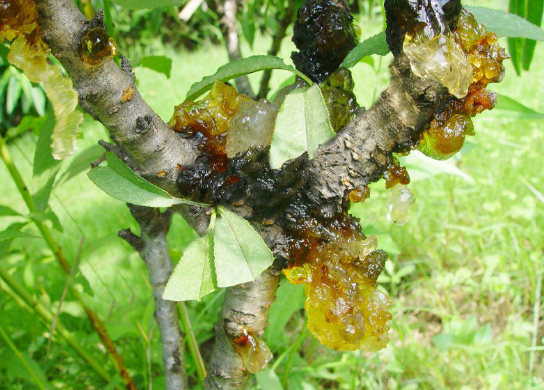
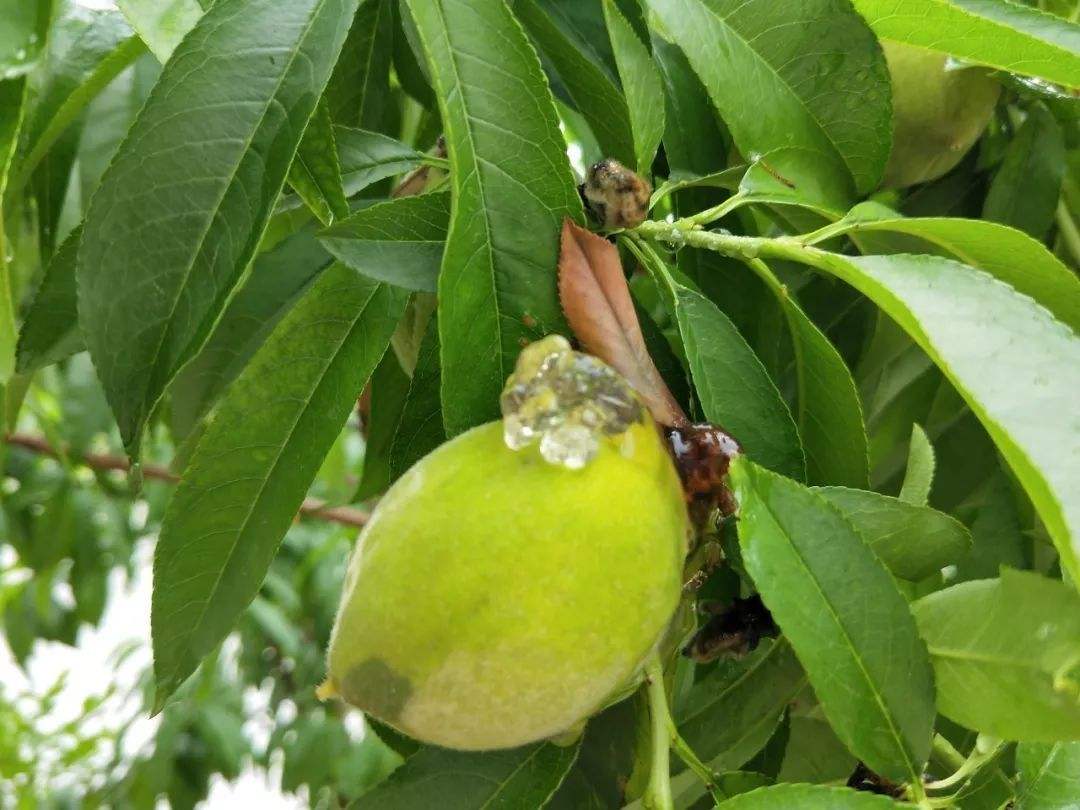
Hazard symptoms: (1) Branches: There are 2 types of gummosis. Lenticel gummosis: In the early stage, slightly raised scar spots centered on lenticel appear, then the scar spots gradually expand and raise, with different sizes (5-13 mm in diameter, 4-10 mm in thickness), and finally the scar spots rupture. Generally, the gum overflows from the center of the scar spot. It is colorless and transparent at the beginning, and gradually becomes reddish-brown after condensation. The scar spots are soft when wet and hard when dry. When the scar spots are cut open, it can be seen that the cortex becomes brown and necrotic, the subcortical layer is filled with viscous gum, and the surface of xylem also becomes brown. Wound gummosis: After insect mouths, cracks, and mechanical wounds appear on fruits and branches, etc., the gum appears at the edge of the wound, and the characteristics and changes of the gum are the same as lenticel gummosis. (2) Fruits: The yellow gum is secreted from the core, overflowing the fruit surface, the diseased part is hardened, and sometimes the fruit will crack. When the disease is severe, the whole tree weakens and eventually withers.
Characteristics of disease occurrence: The pathogen is Botryosphaeria ribis Tose Gross.et Dugg., belonging to ascomycotina fungus. Mycelium and conidia overwinter on diseased branches. In the next year, conidia are produced from late March to mid-April, spread by wind and rain, and infect through lenticels and wounds. Mycelium can grow in the range of 15-35°C, 25-35 °C is suitable, and 4 °C and 40 °C cannot grow normally. The pathogen has a wide range of adaptation to pH, and can grow between 3 and 10, and the best growth is at pH 5 and 6. From April onwards, spores are released whenever there is rainfall. Barren soil, insufficient fertilizer and water, and large tree load can cause disease.
Prevention and control measures:
(1) Select disease-resistant varieties, strengthen nursery bed management, and cultivate healthy and disease-free peach seedlings. Pay attention to ditching and drainage in low-lying waterlogged areas. Increase the application of organic fertilizer and phosphate and potash fertilizer to enhance the tree potential and improve the tree resistance. Control the tree load. Combine with winter pruning to remove diseased branches.
(2) Before germination, brush disease spot with Thiophanate-methyl 70% WP. Scrape off the gum before flowering, and brush Carbendazim 50% WP. From May to June, apply Carbendazim 50% WP, or Thiophanate-methyl 70% WP. Spray every 15 days for 3 to 4 times continuously.
5. Peach noninvasive gummosis
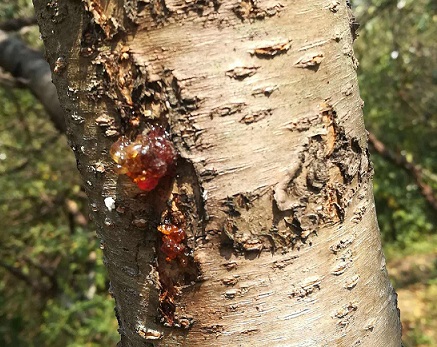
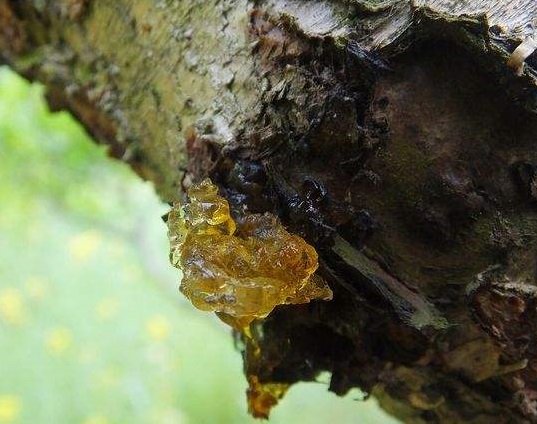
Hazard symptoms: (1) Branches: After the trunk and main branches are infected, the diseased part is slightly swollen at the initial stage of disease. When the sap begins to flow in early spring, translucent yellow gum flows from the diseased part, especially after rain. When the outflowing gum comes into contact with the air, it turns reddish-brown and gelatinous. After drying, it becomes a reddish-brown to dark-brown hard gum. The diseased part is easily infected by saprophytes, so that the cortex and xylem become brown and rot, and in severe cases, the branches or the whole plant die. (2) Leaves: Leaves become yellow and smaller. (3) Fruits: The yellow gum is secreted from the core, overflowing the fruit surface, the diseased part is hardened, and sometimes the fruit will crack. The fruits cannot grow and develop, and have no edible value.
Characteristics of disease occurrence: This is a physiological disease. It usually occurs from April to October. The gummosis is serious in the rainy season, especially after a long-term drought occasionally heavy rain. Old peach trees have serious gummosis. Many wounds caused by various reasons, excessive pruning, and root and crown disorders are easy to get disease. The gummosis with dwarfing stock is more serious than that with vigorous stock, and the gummosis of high grafting site is more serious than that of low grafting sites. Planting too deep, soil compaction, alkaline soil, low-lying terrain, heavy pest and disease damage, improper fertilization, excessive peach tree load, and insufficient branches can easily cause disease.
Prevention and control measures:
(1) Choose sandy loam soil with higher terrain and good drainage when planting. If the soil is sticky, it is necessary to plough deep and add sand to increase soil permeability and organic matter content. In the spring, remove the buds on the main trunk in time to prevent the gummosis caused by cutting. After June to before the leaves fall, do not prune the branches to avoid gum flow.
(2) Apply lime Sulphur (5 Baume degrees) before germination. After winter pruning, apply fungicide to large wounds in time. Deep ploughing should be avoided for gummosis caused by sticky soil. If the gum is found, scrape off in time and sweep up, burn and deeply bury, and then treat with drug.
6. Peach scab
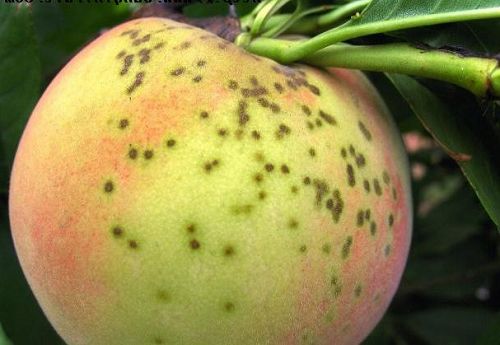
Hazard symptoms: (1) Branches: At first, oval disease spots with purplish-brown edges and light brown centers appear on the surface of shoots. The size is about 3-6mm, and the disease spots become purple or dark brown in the later stage, slightly bulged, and gum flows out from the disease spots. In spring, the spots become gray and black grains densely appear on the surface. The disease spots appear only on the surface of the branches, not deep inside. Suberin cells form beneath the disease spots. (2) Leaves: In the early stage, irregular dark green spots appear on the back of the leaves, and the corresponding spots on the front are also dark green, and finally become purple-red, withered and perforated. The disease spots are small, and can form a long strip of dark brown disease spots on the midrib, which can cause defoliation in severe cases. (3) Fruits: There are light brown spots in the stem depression, which gradually develop into dark brown and then appear as slightly raised black mole-like spots with a size of 2 to 3 mm. When the disease is serious, the disease spots aggregate into pieces, and the pulp can continue to grow, while the growth of the epidermis stops due to death, so the diseased fruit often has "growth" cracking phenomenon. The fruit stem is infected, and the diseased fruit often falls off early.
Characteristics of disease occurrence: The pathogen is Fusicladium carpophilum(Thum)Oud., belonging to deuteromycotina fungus. The mycelium overwinters in the diseased parts of the shoots or the scales of the buds. After the rainfall from April to May, it will be spread by wind, rain and fog droplets. It invades directly through the cuticle of epidermis, and on leaves usually from the back. Conidia can live for 3 months in dry condition. The optimum growth temperature of pathogen is 24-25°C, the highest is 32°C, and the lowest is 2°C. The temperature of conidia germination is 10-32 °C, but 27 °C is the most suitable. Early-maturing varieties are less infected than late-maturing varieties. It is prone to infecting when it is rainy and humid in spring, early summer and at fruit near maturity. Low-lying terrain, close planting, poor ventilation and light transmission can lead to severe disease.
Prevention and control measures:
(1) Select disease-resistant or early-maturing varieties. Pruning in winter removes diseased shoots and reduces the source of pathogen. In the orchard, pay attention to the drainage after rain, and prune it reasonably, so that the orchard has good ventilation and light transmission, which can reduce the incidence of disease.
(2) Apply lime Sulphur (5 Baume degrees) before flowering to eradicate the overwintering pathogen on the branches. Half a month after the flowers falling, apply Mancozeb 80% WP, or Difenoconazole 150g/L + Pyraclostrobin 250g/L SC. Spray every 10-15 days for 3 times continuously.
7. Peach anthracnose
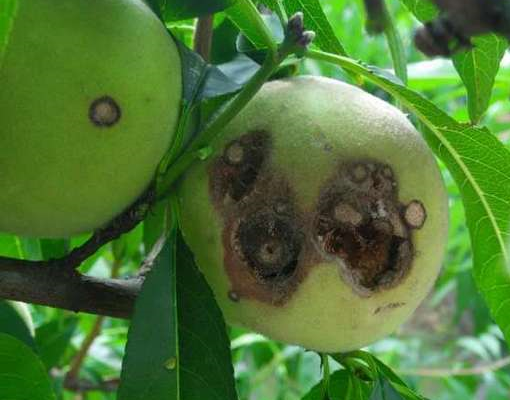
Hazard symptoms: (1) Branches: The new shoot disease spots are oblong, dark green, water- stained, and then gradually turn brown with reddish-brown edges, and slightly sunken. When the weather is wet, there are small orange grains on the surface. The diseased tip is bent to one side. When the disease spots surround the branch for 1 circle, the upper end of the branch dies. (2) Leaves: The leaves take the main vein as the axis, and the two sides are curled towards the front, and some are curled into a tube. The disease spots are nearly round or irregular in shape and light brown, in the later stage, the middle of the spots is gray-brown or gray-white, with small orange-red to black grains, and finally the leaves are perforated. (3) Fruits: The surface of infected young fruit is dark brown, and the development is stagnant. Eventually the young fruit atrophies and hardens. When the slightly larger fruit is diseased, light brown water-stained spots appear at the initial stage, which gradually expand to reddish-brown, round or oval, and significantly sunken. In the later stage, there are small orange grains on the disease spots.
Characteristics of disease occurrence: The pathogen is Colletotrichum gloeosporioides Penz., belonging to deuteromycotina fungus. In the sexual generation, the pathogen is Glomerella persicae Hara., belonging to ascomycotina fungus. They overwinter in the disease shoot tissue or inactivation fruit on the tree. In spring, they are spread by wind, rain and insects, and infect young fruits and new shoots, causing the first infestation. Spores produced on newly disease spots can cause reinfestation. The optimum growth temperature of pathogen is 25°C, the lowest is 12°C, the highest is 33°C, and the lethal temperature is 48°C. The temperature of conidia germination is 26°C, the lowest is 9°C, and the highest is 34°C. In general, early-maturing varieties are more seriously infected, and late-maturing varieties are less. Low temperature and rainy conditions are prone to disease at flowering and young fruit stage. It is prone to infecting in warm, cloudy, foggy, high-humidity environments at pseudo ripening stage of fruit. Excessive growth, close planting, and excessive fruit can lead to severe disease.
Prevention and control measures:
(1) Remove dead branches and inactivation fruits on the tree and fallen leaves on the ground in time. Prevent water accumulation after rain to reduce the humidity in the orchard. Increase the application of phosphate and potash fertilizer to make the tree grow strong and improve the ability to resist disease. The bagging time in the orchard should be appropriately advanced, and it is best to complete the bagging in early May.
(2) Before germination, apply Bordeaux mixture (1:1:100), or lime Sulphur (3-4 Baume degrees) mixture with 0.3% sodium pentachlorophenate. From falling flowers to late May, apply Difenoconazole 150g/L + Pyraclostrobin 250g/L SC. Spray every 7-10 days for 2 to 3 times continuously. During the growing season of peach trees, copper fungicide should be used with caution to avoid phytotoxicity.